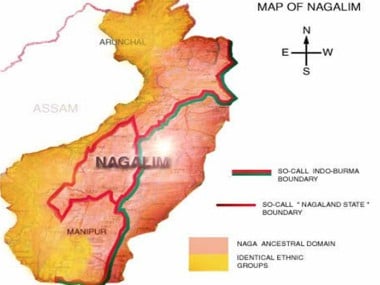Despite the diktat of the civil society groups and Naga organisations to boycott the upcoming Assembly elections in Nagaland over the demand of Nagalim, almost all mainstream political parties filed nominations for 27 February polls.
However, the demand for Greater Nagaland, the proposed sovereign State that will consist of all the Naga-inhabited areas of neighbouring Assam, Manipur, Arunachal Pradesh and a large tract of Myanmar, still looms large over the state elections.
Naga groups and demand for Greater Nagaland or Nagalim
The National Socialist Council of Nagalim Isak-Muivah (NSCN-IM) is one of the largest insurgent outfits, which has been demanding a separate ‘Nagalim’ state for over six decades.

Representational image. Reuters
According to Rediff, the NSCN was a Christian Naga nationalist militant group formed after opposition rose against the Shillong Accord signed by the then Naga National Council with the Government of India.
Under the Shillong Accord, it was agreed that Naga National Council (NNC) would give up arms. However, a group of around 140 members led by Thuingaleng Muivah, refused to accept the Shillong Accord, and formed the National Socialist Council of Nagaland in 1980, according to The Indian Express. Isak Chisi Swu and SS Khaplang were two other associates of Muivah.
In 1988, the NSCN split into NSCN (IM) and NSCN (K). Today, the NSCN (IM) is seen as the most prominent among all Naga groups.
NSCN-IM is of the opinion that Naga region was never a part of India and that India's first prime minister Jawaharlal Nehru’s argument that India had "inherited" the Naga area from the British was flawed.
The NSCN-IM demands “Greater Nagaland” which will have about 1,20,000 sq kilometre area. Today, the state of Nagaland covers 16,527 sq kilometre area.
Modi government's treaty with NSCN (IM)
In August 2015, Centre and the NSCN (IM) signed a landmark peace accord in the presence of Narendra Modi, Home Minister Rajnath Singh and National Security Advisor Ajit Doval to end animosity and "usher into a new era of peace".
The signing of the pact was the culmination of over 80 rounds of negotiations that spanned 16 years with first breakthrough in 1997 when ceasefire agreement was sealed.
"This agreement will end the oldest insurgency in the country. It will restore peace and pave the way for prosperity in the North East. It will advance a life of dignity, opportunity and equity for the Naga people, based on their genius and consistent with the uniqueness of the Naga people and their culture and traditions," Modi had said after the accord was signed.
The accord however, according to this Indian Express report did not involve redrawing the state’s borders. What the deal involved was creating a mechanism which would create institutions allowing autonomy to Naga tribes living across the border in Manipur.
Why three North East states oppose Nagalim?
In March last year, NSCN (IM) general secretary Thuingaleng Muivah, announced that the Centre had accepted the demand for Greater Nagaland, sparking fear and anger in Manipur, Assam, and Arunachal Pradesh, Firstpost had reported.
The Centre had, however, strongly refuted the claim that it had agreed to carve out Nagalim, saying no such decision was taken.

Map of Nagalim proposed by NSCN (IM). Image courtesy: www.nscnonline.org
In October last year, amid the debate over whether Assam and Manipur would loose parts of its land to Nagalim, Assam chief minister Sarbananda Sonowal had said that "not an inch of state’s land would be parted with", The Telegraph had reported.
Similarly, Manipur is also against the Greater Nagaland demand since NSCN (IM) wants the Naga-inhabited hill districts of Manipur included in Nagalim.
RSS' draft plan for Greater Nagaland
In January this year, Jagadamba Mall, a RSS functionary who has been working in Nagaland for the last 40 years, came up with a draft agreement between the NSCN (IM) and Government of India.
Mall had clarified that draft plan by no means was connected to the BJP or the RSS.
Mall's draft for Nagaland peace process, according to The Wire, proposed a union territory (UT) carved out of the five border districts of Nagaland. The union territory, named “Frontier Nagaland”, comprises five districts bordering Myanmar.
BJP plays it safe
In an interview with The Times of India on 7 February, responding to the question on BJP's stand on the demand for Nagalim, party national general secretary Ram Madhav had said that all the stakeholders would be taken into confidence before the the Naga Peace Accord was concluded.
"So people need not have any fears about any issues. The views of all the concerned sections will be taken into account. If there are any issues that need any consultation with other states, I’m sure the government will do that," Madhav was quoted as saying by The Times of India.
Published Date: Feb 12, 2018 12:20 PM | Updated Date: Feb 12, 2018 12:20 PM